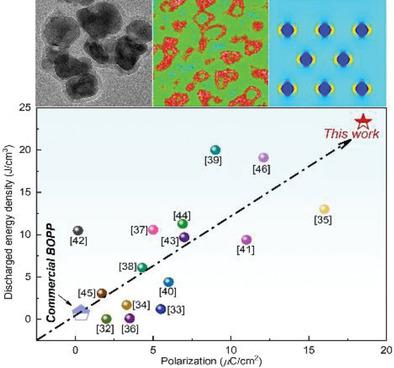当前位置:
X-MOL 学术
›
Adv. Electron. Mater.
›
论文详情
Our official English website, www.x-mol.net, welcomes your
feedback! (Note: you will need to create a separate account there.)
Interface-Tailored Relaxor Ferroelectric Nanocomposites with Ultrahigh-Insulation Shell of Fluorinated Aromatic Polythiourea for High-Capacitance Energy Storage Applications
Advanced Electronic Materials ( IF 5.3 ) Pub Date : 2022-09-07 , DOI: 10.1002/aelm.202200670 Ning Zhu 1 , Jiahao Liu 2 , Jingtao Zhou 1 , Lei Zhang 3 , Ni Yao 4 , Xiaolian Liu 1 , Yingxin Chen 1 , Jian Zhang 1 , Xuefeng Zhang 1
Advanced Electronic Materials ( IF 5.3 ) Pub Date : 2022-09-07 , DOI: 10.1002/aelm.202200670 Ning Zhu 1 , Jiahao Liu 2 , Jingtao Zhou 1 , Lei Zhang 3 , Ni Yao 4 , Xiaolian Liu 1 , Yingxin Chen 1 , Jian Zhang 1 , Xuefeng Zhang 1
Affiliation

|
The strategy of interface engineering plays a prominent role in obtaining desirable dielectric performance of polymer nanocomposites. In this study, ultrahigh-insulation BaTiO3@fluorinated aromatic polythiourea (BT@ArPFTU) nanoparticles (NPs), which are successfully synthesized via microwave-initiated polymerization, are served as novel nanofillers to prepare poly(vinylidenefluoride-trifluoroethylenechlorotrifuoroethylene)-based (P(VDF-TrFE-CTFE)-based) nanocomposites for capacitor applications. The ArPFTU coating shell forms a strong interface with 30-nm thickness between BT and the matrix. It not only contributes to the suppression of current density at the interfaces, the regulation of interfacial charge distribution and tolerating high electric-field strength, but also favors the improvement in dielectric constant and electric polarization due to interfacial polarization, as confirmed by finite element simulations and experimental results. In addition, the direct observation of electric-polarization enhancement at the interfaces in the P(VDF-TrFE-CTFE)/BT@ArPFTU nanocomposites is well probed by piezoelectric force microscopy. Remarkably, with small loading of BT@ArPFTU NPs, relaxor ferroelectric nanocomposites display an unprecedented discharged energy density of 23.1 J cm−3 and the charge–discharge efficiency of 65%, which is much larger than that of other types of BT-based polymer nanocomposites and commercial biaxially oriented polypropylene of 0.71 J cm−3. This systematic study further paves a new avenue to design high-performance polymer nanocomposites by interfacial architecture for capacitor application.
中文翻译:

具有超高绝缘氟化芳族聚硫脲外壳的界面定制弛豫铁电纳米复合材料用于高容量储能应用
界面工程策略在获得聚合物纳米复合材料所需的介电性能方面起着重要作用。在这项研究中,超高绝缘BaTiO 3通过微波引发聚合成功合成的@氟化芳香族聚硫脲(BT@ArPFTU)纳米粒子(NPs)被用作新型纳米填料制备聚(偏二氟乙烯-三氟乙烯-氯三氟乙烯)基(P(VDF-TrFE-CTFE)基) 用于电容器应用的纳米复合材料。ArPFTU 涂层壳在 BT 和基质之间形成了 30 nm 厚度的强界面。它不仅有助于抑制界面处的电流密度,调节界面电荷分布和耐受高电场强度,而且有利于界面极化引起的介电常数和电极化的改善,正如有限元模拟所证实的那样和实验结果。此外,P(VDF-TrFE-CTFE)/BT@ArPFTU 纳米复合材料界面处的电极化增强的直接观察可以通过压电力显微镜很好地探测到。值得注意的是,在 BT@ArPFTU NPs 负载量小的情况下,弛豫铁电纳米复合材料显示出前所未有的 23.1 J cm-2 放电能量密度-3和 65% 的充放电效率,远高于其他类型的 BT 基聚合物纳米复合材料和商用双轴取向聚丙烯的 0.71 J cm -3。该系统研究进一步为通过界面结构设计用于电容器应用的高性能聚合物纳米复合材料铺平了道路。
更新日期:2022-09-07
中文翻译:

具有超高绝缘氟化芳族聚硫脲外壳的界面定制弛豫铁电纳米复合材料用于高容量储能应用
界面工程策略在获得聚合物纳米复合材料所需的介电性能方面起着重要作用。在这项研究中,超高绝缘BaTiO 3通过微波引发聚合成功合成的@氟化芳香族聚硫脲(BT@ArPFTU)纳米粒子(NPs)被用作新型纳米填料制备聚(偏二氟乙烯-三氟乙烯-氯三氟乙烯)基(P(VDF-TrFE-CTFE)基) 用于电容器应用的纳米复合材料。ArPFTU 涂层壳在 BT 和基质之间形成了 30 nm 厚度的强界面。它不仅有助于抑制界面处的电流密度,调节界面电荷分布和耐受高电场强度,而且有利于界面极化引起的介电常数和电极化的改善,正如有限元模拟所证实的那样和实验结果。此外,P(VDF-TrFE-CTFE)/BT@ArPFTU 纳米复合材料界面处的电极化增强的直接观察可以通过压电力显微镜很好地探测到。值得注意的是,在 BT@ArPFTU NPs 负载量小的情况下,弛豫铁电纳米复合材料显示出前所未有的 23.1 J cm-2 放电能量密度-3和 65% 的充放电效率,远高于其他类型的 BT 基聚合物纳米复合材料和商用双轴取向聚丙烯的 0.71 J cm -3。该系统研究进一步为通过界面结构设计用于电容器应用的高性能聚合物纳米复合材料铺平了道路。











































 京公网安备 11010802027423号
京公网安备 11010802027423号